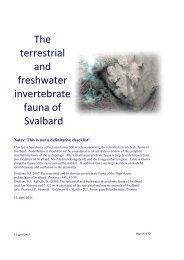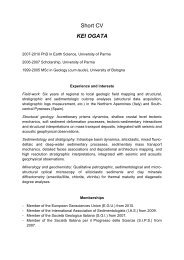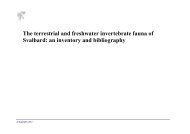Arctic plant ecology: From tundra to polar desert in Svalbard - Unis
Arctic plant ecology: From tundra to polar desert in Svalbard - Unis
Arctic plant ecology: From tundra to polar desert in Svalbard - Unis
Create successful ePaper yourself
Turn your PDF publications into a flip-book with our unique Google optimized e-Paper software.
The temperature measurements at 10 cm soil depth <strong>in</strong> the plots with E. wettste<strong>in</strong>ii<br />
showed a higher temperature (~0.51 °C) <strong>in</strong> comparison <strong>to</strong> the plots without E.<br />
wettste<strong>in</strong>ii, however, the ttest showed no significance.<br />
One patch of E. wettste<strong>in</strong>ii was found at Colesdalen <strong>in</strong> 1998 and n<strong>in</strong>e patches were<br />
discovered <strong>in</strong> 2002 (Alsos & Lund 1999, Alsos et al. 2004). This <strong>in</strong>crease <strong>in</strong> patches<br />
correlates with the temperature diagram which shows a peak <strong>in</strong> 1998 and one <strong>in</strong> 2002<br />
due <strong>to</strong> <strong>in</strong>creased summer temperature. By July 2007 the n<strong>in</strong>e patches had spread <strong>to</strong><br />
one big cont<strong>in</strong>uous patch. Is the spread of E. wettste<strong>in</strong>ii <strong>in</strong> Colesdalen a consequence<br />
of <strong>in</strong>creased mean summer temperature on <strong>Svalbard</strong>? It is worth not<strong>in</strong>g on the<br />
mounta<strong>in</strong> Sandalsnuten at F<strong>in</strong>se <strong>in</strong> Norway, growth and seed production of E.<br />
wettste<strong>in</strong>ii were largely temperature dependent (Nyléhn & Totland 1999). However,<br />
the effect of temperature on the spread of E. wettste<strong>in</strong>ii must be <strong>in</strong>direct due <strong>to</strong><br />
<strong>in</strong>creased growth and quality of the host <strong>plant</strong> caused by elevated temperature. As a<br />
consequence, the population of E. wettste<strong>in</strong>ii could actually decrease due <strong>to</strong> <strong>in</strong>creased<br />
competition if we assume that a warmer climate leads <strong>to</strong> a denser vegetation cover.<br />
However, temperatures on <strong>Svalbard</strong> may have <strong>to</strong> rise substantially before this process<br />
will take effect. Increased temperatures and changes <strong>in</strong> species composition can lead<br />
<strong>to</strong> disappearance of some of the host species of E. wettste<strong>in</strong>ii and <strong>in</strong>troduction of new<br />
species. Due <strong>to</strong> the broad host range of E. wettste<strong>in</strong>ii one can assume that this might<br />
not <strong>in</strong>fluence the ability <strong>to</strong> have proper species <strong>in</strong> the surround<strong>in</strong>gs <strong>to</strong> parasitise<br />
(Nyléhn & Totland 1999, Seel & Press 1993).<br />
Dense patches of E. wettste<strong>in</strong>ii <strong>in</strong> Colesdalen were observed near bare ground ma<strong>in</strong>ly<br />
caused by frost disturbance. Open soil patches are needed for seed establishment<br />
(Molau 1993, Seel & Press 1993). Longterm consequences of climatic changes may<br />
lead <strong>to</strong> less frost disturbance and, consequently, fewer open soil patches. The result<strong>in</strong>g<br />
dense vegetation cover may limit the growth of E. wettste<strong>in</strong>ii <strong>in</strong> some places.<br />
The thermophilic annual E. wettste<strong>in</strong>ii has not only the potential <strong>to</strong> spread when mean<br />
July temperatures are ris<strong>in</strong>g by 1 degree Kelv<strong>in</strong>, this be<strong>in</strong>g the temperature <strong>in</strong>crease<br />
be<strong>in</strong>g observed for the last ten years, but is already expand<strong>in</strong>g its habitat.<br />
Conclusion<br />
Species on <strong>Svalbard</strong> and Greenland possess the same ecological amplitudes,<br />
regardless of their occurrence <strong>in</strong> the Low or High <strong>Arctic</strong>. Widespread species on<br />
<strong>Svalbard</strong> do not necessarily possess wide ecological amplitudes and widespread <strong>plant</strong>s<br />
do not naturally display wide ecological amplitudes. These conclusions may be of<br />
major <strong>in</strong>terest when consider<strong>in</strong>g species responses <strong>to</strong> climate change. A variety of<br />
arctic species may have ecological amplitudes large enough <strong>to</strong> accommodate for<br />
climate change. A population of the thermophilic annual Euphrasia wettste<strong>in</strong>ii seems<br />
<strong>to</strong> be spread<strong>in</strong>g, perhaps due <strong>to</strong> ris<strong>in</strong>g temperatures on <strong>Svalbard</strong>, thereby <strong>in</strong>dicat<strong>in</strong>g<br />
early signs of climate change <strong>in</strong> the <strong>Arctic</strong>.<br />
References<br />
ACIA. 2006: <strong>Arctic</strong> Climate Impact Assessment: Scientific Report Cambridge.<br />
51








